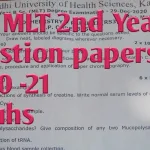Informational and Educational Questions and Answers on Previous Question Papers of Pharm D 1st Year
Pharm D 1st year students often seek question papers to practice and prepare effectively for exams. Below is a collection of questions and answers for all subjects, carefully curated to support your learning. The format ensures clarity, covering essential topics in each subject comprehensively.
Human Anatomy and Physiology
Question: What are the primary functions of the skeletal system?
Answer: The skeletal system provides support, protects internal organs, facilitates movement, stores minerals, and produces blood cells.
Question: What is the structure of a neuron?
Answer: A neuron consists of a cell body, dendrites, and an axon, which transmits electrical signals in the nervous system.
Question: What is the role of hemoglobin in the body?
Answer: Hemoglobin in red blood cells carries oxygen from the lungs to tissues and transports carbon dioxide back to the lungs for exhalation.
Question: Define homeostasis and its importance.
Answer: Homeostasis is the body’s ability to maintain a stable internal environment, essential for optimal cellular function and survival.
Question: What are the types of muscle tissue?
Answer: The three types of muscle tissue are skeletal, cardiac, and smooth muscles, each with specific structures and functions.
Question: How does the heart function in the circulatory system?
Answer: The heart pumps oxygenated blood to the body and deoxygenated blood to the lungs, maintaining blood circulation.
Question: What are the components of blood?
Answer: Blood consists of plasma, red blood cells, white blood cells, and platelets, each serving unique functions in the body.
Question: Explain the structure and function of the lungs.
Answer: The lungs have alveoli that facilitate gas exchange, allowing oxygen to enter the blood and carbon dioxide to be expelled.
Question: What are the functions of the liver?
Answer: The liver detoxifies chemicals, produces bile, stores glycogen, and synthesizes proteins for blood clotting.
Question: Define the endocrine system.
Answer: The endocrine system consists of glands that produce hormones to regulate metabolism, growth, reproduction, and homeostasis.
Question: What are synovial joints?
Answer: Synovial joints are movable joints filled with synovial fluid, enabling smooth movement between bones.
Question: What is the role of the kidneys in the body?
Answer: The kidneys filter waste products from the blood, regulate fluid balance, and maintain electrolyte levels.
Question: What is the structure of the human heart?
Answer: The heart has four chambers: two atria and two ventricles, with valves ensuring unidirectional blood flow.
Question: What are the types of blood vessels?
Answer: Blood vessels include arteries, veins, and capillaries, which transport blood throughout the body.
Question: Explain the process of digestion in the stomach.
Answer: The stomach secretes gastric juice containing enzymes and acid to break down food into a semi-liquid form for further digestion.
Question: What is the function of the pancreas?
Answer: The pancreas produces insulin and glucagon to regulate blood sugar and secretes enzymes for digestion.
Question: What are neurotransmitters?
Answer: Neurotransmitters are chemical messengers that transmit signals between neurons or from neurons to muscles.
Question: Define blood pressure.
Answer: Blood pressure is the force exerted by circulating blood on the walls of blood vessels, measured as systolic and diastolic pressure.
Question: What is the function of the lymphatic system?
Answer: The lymphatic system helps remove waste and toxins, transports lymph, and plays a role in immune defense.
Pharmaceutics
Question: What is the difference between solutions and suspensions?
Answer: Solutions are clear mixtures where solutes dissolve completely, while suspensions have particles dispersed in a liquid that do not dissolve.
Question: Define bioavailability.
Answer: Bioavailability refers to the extent and rate at which a drug reaches systemic circulation and its target site.
Question: What are emulsions?
Answer: Emulsions are mixtures of two immiscible liquids stabilized by an emulsifying agent.
Question: Explain the term “half-life” in pharmacokinetics.
Answer: Half-life is the time taken for the concentration of a drug in the blood to reduce by half.
Question: What is a buffer solution?
Answer: A buffer solution resists changes in pH when an acid or base is added, maintaining a stable environment.
Question: What is the role of excipients in drug formulations?
Answer: Excipients are inactive ingredients added to drugs to enhance stability, delivery, and patient acceptability.
Question: What are enteric-coated tablets?
Answer: Enteric-coated tablets have a protective layer that prevents disintegration in the stomach, allowing the drug to reach the intestine.
Question: Define sterilization and its types.
Answer: Sterilization is the process of killing or removing all microorganisms, using methods like heat, filtration, and radiation.
Question: What are suppositories?
Answer: Suppositories are solid dosage forms inserted into body cavities like the rectum, where they dissolve or melt to release the drug.
Question: Explain the term “sustained-release formulation.”
Answer: Sustained-release formulations release the drug slowly over time, maintaining a consistent blood concentration.
Question: What is the function of a mortar and pestle in pharmaceutics?
Answer: A mortar and pestle are used to grind and mix ingredients for compounding medications.
Question: Define isotonic solutions.
Answer: Isotonic solutions have the same osmotic pressure as body fluids, preventing cell shrinkage or swelling when administered.
Question: What are granules?
Answer: Granules are agglomerates of powdered drug substances, used for easier handling and accurate dosing.
Question: What is meant by “drug stability”?
Answer: Drug stability refers to the ability of a drug to maintain its identity, strength, and purity throughout its shelf life.
Question: Explain transdermal drug delivery systems.
Answer: Transdermal systems deliver drugs through the skin into systemic circulation using patches or gels.
Question: What are diluents in tablet formulations?
Answer: Diluents are inactive substances added to tablets to increase their volume and improve handling.
Question: Define “disintegration time” for tablets.
Answer: Disintegration time is the duration it takes for a tablet to break down into smaller particles in a solution.
Question: What is the purpose of coating tablets?
Answer: Coating tablets enhances stability, masks taste, and controls the release of the drug.
Question: What are ointments?
Answer: Ointments are semi-solid preparations used for external application to deliver drugs to the skin.
Preparing with previous question papers is crucial for Pharm D 1st year students. It helps improve understanding, gain confidence, and perform better in exams. By practicing these questions and answers, students can strengthen their knowledge of essential concepts across all subjects. Systematic preparation and revision can make a significant difference in academic success.
Latest Posts
- Step-by-step guide to download and apply for jee mains admit card 202
- Comprehensive 2025 government holidays and recruitment details for job seekers
- JEE Mains Admit Card 2025: Your Step-by-Step Guide to Downloading the Hall Ticket
- Everything You Need to Know About 2025 Government Holidays Recruitment
- Comprehensive Guide to rrb d group recruitment 2025 – Eligibility, Vacancies, and Application
- Detailed guide to nps trust recruitment 2025 vacancies, eligibility and apply process
- Comprehensive guide to hpcl recruitment 2025 notification, vacancies, and application process
- ignou bed admission 2025 complete recruitment guide with eligibility and process
- Comprehensive Guide to Indian Army Agniveer Recruitment 2025 Notification and Jobs
- Everything You Must Know About CBSE Board Exams 2025 Changes & New Rules





